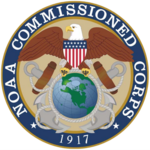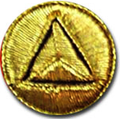NOAA Commissioned Officer Corps
| National Oceanic and Atmospheric Administration Commissioned Officer Corps | |
|---|---|
 Emblem of the NOAA Commissioned Officer Corps | |
| Founded | 22 May 1917[1] (106 years, 10 months) |
| Country | |
| Type | Uniformed service |
| Size | 321 officers[2] 15 ships[3] 10 aircraft[4] |
| Part of | |
| Garrison/HQ | Silver Spring, Maryland, U.S. |
| Nickname(s) | "NOAA Corps" |
| Motto(s) | "Science, service, stewardship."[5] |
| Colors | [6] |
| March |
|
| Engagements | |
The National Oceanic and Atmospheric Administration Commissioned Officer Corps (informally the NOAA Corps) is one of eight federal
The NOAA Corps traces its origins to the establishment of the United States Coast and Geodetic Survey Corps on May 22, 1917, which the service recognizes as its official date of establishment.[11][12] The Coast and Geodetic Survey Corps became the Environmental Science Services Administration Corps in 1965, which in turn became the NOAA Corps in 1970.[12][13]
Mission
The NOAA Corps is the smallest
History
Early history
The NOAA Commissioned Officer Corps traces its roots to the
With the outbreak of the Spanish–American War in April 1898, the U.S. Navy again withdrew all of its officers from Coast and Geodetic Survey assignments. They returned after the war ended in August 1898, but the system of U.S. Navy officers and men crewing the Survey's ships that had prevailed for most of the 19th century came to an end when the appropriation law approved on June 6, 1900, provided for "all necessary employees to man and equip the vessels," instead of U.S. Navy personnel. The law took effect on July 1, 1900; at that point, all U.S. Navy personnel assigned to the Survey's ships remained aboard until the first call at each ship's home port, where they transferred off, with the Survey reimbursing the Navy for their pay accrued after July 1, 1900.[17] From July 1900, the Coast and Geodetic Survey continued as an entirely civilian-run organization until after the United States entered World War I in April 1917.[15]
Coast and Geodetic Survey Corps

To avoid the dangers that Coast Survey personnel had faced during the Civil War of being executed as spies if captured by the enemy, the United States Coast and Geodetic Survey Corps was established on 22 May 1917, giving Coast and Geodetic Survey officers a
The Coast and Geodetic Survey Corps returned to peacetime scientific pursuits after the war.
When the United States entered
After the war ended in August 1945, the Coast and Geodetic Survey again returned to peacetime scientific duties, although a significant amount of its work in the succeeding years was related to support of military and naval requirements during the Cold War.[15]
ESSA Corps


When the Coast and Geodetic Survey was transferred to the newly established
Following the establishment of the ESSA,
NOAA Corps
The ESSA was reorganized and expanded to become the new National Oceanic and Atmospheric Administration on October 3, 1970.[19] As a result, the ESSA Corps was redesignated the National Oceanic and Atmospheric Administration Commissioned Officer Corps, known informally as the NOAA Corps. Rear Admiral Harley D. Nygren was appointed as the first director of the new NOAA Corps.
In 1972, the NOAA Corps became the first
On January 2, 2014, Michael S. Devany was promoted to vice admiral upon assuming duties as Deputy Under Secretary for Operations at NOAA, becoming only the second vice admiral in the combined history of the Coast and Geodetic Survey Corps, ESSA Corps, and NOAA Corps, and the first since the promotion of Vice Admiral Karo in 1965.[23]
Directors of the Coast and Geodetic Survey Corps, ESSA Corps, and NOAA Corps
| No. | Portrait | Name | Tenure | Notes | |
|---|---|---|---|---|---|
| United States Coast and Geodetic Survey Corps | |||||
| 1 | 
|
Ernest L. Jones (1876–1929) |
1917–1929 | Superintendent (title changed to "Director" in 1919) of the U.S. Coast and Geodetic Survey from 1915 until he died in 1929. As such, led the Coast and Geodetic Survey Corps from its creation in 1917 until 1929.[24] Was a colonel and intelligence officer in the U.S. Army during World War I.[25] | |
| 2 | 
|
Rear Admiral Raymond S. Patton (1882–1937) |
1929–1937 | Director, U.S. Coast and Geodetic Survey, which included leadership of the Coast and Geodetic Survey Corps, from 1929 until he died in 1937. Served as director in the rank of captain until he was promoted to rear admiral in 1936. Was the first flag officer in Coast and Geodetic Survey Corps history.[24] | |
| 3 | 
|
Rear Admiral Leo O. Colbert (1883–1968) |
1938–1950 | Director, U.S. Coast and Geodetic Survey, from 1938 to 1950, which included leadership of the Coast and Geodetic Survey Corps.[24] | |
| 4 | 
|
Rear Admiral Robert F.A. Studds (1896–1962) |
1950–1955 | Director, U.S. Coast and Geodetic Survey, from 1950 to 1955, which included leadership of the Coast and Geodetic Survey Corps.[24] | |
| 5 | 
|
Rear Admiral H. Arnold Karo (1903–1986) |
1955–1965 | Last Director, Coast and Geodetic Survey Corps (1955–1965); served as Director of the Coast and Geodetic Survey. At end of the tour as Director, simultaneously transferred to the new ESSA Corps and received a promotion to vice admiral on 13 July 1965 to serve as Deputy Administrator, Environmental Science Services Administration (ESSA), from 1965 to 1967. The first officer in the combined history of the Coast and Geodetic Survey Corps and ESSA Corps officer to achieve the rank of vice admiral.[24] | |
| United States Environmental Science Services Administration Commissioned Officer Corps (ESSA Corps) | |||||
| 6 | 
|
Rear Admiral James C. Tison Jr. (1908–1991) |
1965–1968 | First Director, ESSA Corps. Served simultaneously as Director, U.S. Coast and Geodetic Survey (1965–1968).[24] | |
| 7 | 
|
Rear Admiral Don A. Jones (1912–2000) |
1968–1970 | Last Director, ESSA Corps. Served as Director, U.S. Coast and Geodetic Survey (1968–1970). Then served in NOAA Commissioned Officer Corps and was the first Director, National Ocean Survey, from 1970 to 1972.[24] | |
| National Oceanic and Atmospheric Administration Commissioned Officer Corps (NOAA Corps) | |||||
| 8 | 
|
Rear Admiral Harley D. Nygren (1924–2019) |
1970–1981 | First Director, NOAA Commissioned Officer Corps[26] | |
| 9 | 
|
Rear Admiral Kelly E. Taggart (1932–2014) |
1981–1986 | [27] | |
| 10 | 
|
Rear Admiral Francis D. Moran (b. 1935) |
1986–1990 | [28] | |
| 11 | 
|
Rear Admiral Sigmund R. Petersen |
1990–1995 | [29] | |
| 12 | 
|
Rear Admiral William L. Stubblefield (b. 1940) |
1995–1999 | [30] | |
| 13 | 
|
Rear Admiral Evelyn J. Fields (b. 1949) |
1999–2003 | The first African-American in the combined history of the Coast and Geodetic Survey Corps, ESSA Corps, and NOAA Corps to serve as director.[31]
| |
| 14 | 
|
Rear Admiral Samuel P. De Bow Jr. |
2003–2007 | [32] | |
| 15 | 
|
Rear Admiral Jonathan W. Bailey |
2007–2012 | [33] | |
| 16 | 
|
Rear Admiral Michael S. Devany |
2012–2014 | Promoted to vice admiral on 2 January 2014, only the second officer to achieve that rank in the combined history of the Coast and Geodetic Survey Corps, ESSA Corps, and NOAA Corps, and the first to do so since Vice Admiral Karo in 1965.[23] After a tour as Director, became Deputy Under Secretary for Operations, NOAA.[34][35] | |
| 17 | 
|
Rear Admiral David A. Score |
2014–2017 | [36] | |
| 18 | 
|
Rear Admiral Michael J. Silah |
2017–2021 | [37] | |
| 19 | 
|
Rear Admiral Nancy A. Hann |
2021–Present | [38] | |
Commissioned officers
Ranks and insignia
The NOAA Corps uses the same naval
Unless already on active duty as a commissioned officer in any of the other U.S. military services and transferring their commission from that service, new NOAA Corps officers are appointed via direct commission and must complete a 19-week basic officer training class (BOTC)[42] at the United States Coast Guard Officer Candidate School at the United States Coast Guard Academy before entering active duty.
NOAA Corps officers receive the same
Unlike their United States Armed Forces counterparts, NOAA Corps officers do not require their rank appointments and promotions to be confirmed by the United States Senate, and only require approval from the president.[43]
| Uniformed services pay grade | Special grade | O-10 | O-9 | O-8 | O-7 | O-6 | O-5 | O-4 | O-3 | O-2 | O-1 | Officer candidate/Cadet | ||||||||||||||||||||||||
|---|---|---|---|---|---|---|---|---|---|---|---|---|---|---|---|---|---|---|---|---|---|---|---|---|---|---|---|---|---|---|---|---|---|---|---|---|

|

|

|

|

|

|

|

|

|
||||||||||||||||||||||||||||
| Vice admiral | Rear admiral | Rear admiral (lower half) |
Captain | Commander | Lieutenant commander | Lieutenant | Lieutenant (junior grade) |
Ensign | ||||||||||||||||||||||||||||
| Abbreviation | VADM | RADM | RDML | CAPT | CDR | LCDR | LT | LTJG | ENS | |||||||||||||||||||||||||||
| NATO code | OF-10 | OF-9 | OF-8 | OF-7 | OF-6 | OF-5 | OF-4 | OF-3 | OF-2 | OF-1 | OF(D) | Student officer | ||||||||||||||||||||||||
Rank flags
NOAA Corps flag officers are authorized the use of rank flags.
-
Flag of a NOAA Corps
vice admiral -
Flag of a NOAA Corps
rear admiral -
Flag of a NOAA Corps
rear admiral (lower half)
Militarization
NOAA Corps officers can be militarized by the President of the United States under the provisions of 33 U.S.C. § 3061, which states:
The President may, whenever in the judgment of the President a sufficient national emergency exists, transfer to the service and jurisdiction of a military department such vessels, equipment, stations, and officers of the Administration as the President considers to be in the best interest of the country. An officer of the Administration transferred under this section, shall, while under the jurisdiction of a military department, have proper military status and shall be subject to the laws, regulations, and orders for the government of the Army, Navy, or Air Force, as the case may be, insofar as the same may be applicable to persons whose retention permanently in the military service of the United States is not contemplated by law.[44]
Uniforms
For formal
-
NOAA Corps Combination Cap Device
-
NOAA Corps Device
-
An ODUlieutenant commander rank insignia
-
NOAA Corpsservice dress blues
Awards and decoration
Flag

Although the U.S. Coast and Geodetic Survey and ESSA had their own flags, neither the Coast and Geodetic Survey Corps or ESSA Corps did. The NOAA Corps adopted its flag on 7 March 2002, the last of the then-seven uniformed services of the United States to have its own distinctive flag.[45]
The flag has a
Official song
In 1988, the NOAA Corps adopted a
See also
- National Oceanic and Atmospheric Administration Fisheries Office of Law Enforcement
- NOAA ships and aircraft
References
- ^ As the U.S. Coast and Geodetic Survey Corps.
- ^ "About Office of Marine and Aviation Operations". Office of Marine and Aviation Operations. Retrieved January 2, 2022.
- ^ "Ships Office of Marine and Aviation Operations". Office of Marine and Aviation Operations. Retrieved January 2, 2022.
- ^ "Aircraft Operations Office of Marine and Aviation Operations". Office of Marine and Aviation Operations. Retrieved January 2, 2022.
- ^ Goodwin, Mel (July 19, 2012). Sbeih, Nadia (ed.). "NOAA Introduction" (PDF). U.S. Department of Commerce. National Oceanic and Atmospheric Administration. National Ocean Service. p. 1.http://celebrating200years.noaa.gov/edufun/book/NOAAintroduction.pdf
- ^ "About the NOAA emblem and logo". noaa.gov. March 31, 2022. Retrieved April 10, 2022.
- ^ "Forward With NOAA (NOAA Corps Song) - Office of Marine and Aviation Operations".
- ^ a b "History of the NOAA Commissioned Corps". Archived from the original on August 25, 2009.
- ^ Note: Also concurrently serves as Director, Office of Marine and Aviation Operations
- ^ Note: Also concurrently serves as Deputy Director for Operations, Office of Marine and Aviation Operations
- ^ "The NOAA Corps: Celebrating a Century of Service (1917-2017) | Office of Marine and Aviation Operations". NOAA Corps. Retrieved February 21, 2021.
- ^ a b US Department of Commerce, National Oceanic and Atmospheric Administration. "NOAA Ocean Podcast: Celebrating 100 Years of NOAA Corps". NOAA Corps. Retrieved February 21, 2021.
- ^ "History of the NOAA Corps". Archived from the original on August 25, 2009.
- ^ a b Rensberger, Boyce (September 10, 1986). "The Few, the Proud -- the NOAA?" – via washingtonpost.com.
- ^ a b c d e f g "NOAA History /NOAA Legacy/NOAA Corps and the Coast and Geodetic Survey".
- ^ "NOAA History - NOAA Legacy Timeline - 1800s".
- ^ U.S. Coast and Geodetic Survey (1901). Report Of The Superintendent of the Coast And Geodetic Survey Showing The Progress Of Work From July 1, 1900 To June 30, 1901. Washington, D.C.: U.S. Government Printing Office. pp. 15, 17, 109.
- ^ "NOAA History - NOAA Legacy/Historic Documents - Reorg Plan Establishing ESSA Under Dept. of Commerce".
- ^ Reorganization Plan No. 4 of 1970, reprinted with amendments in 5 U.S.C. app. at 1557–61. Section 3(d) states: "The Commissioned Officer Corps of the Environmental Science Services Administration shall become the Commissioned Officer Corps of the National Oceanic and Atmospheric Administration."
- ^ "NOAA History - NOAA Legacy Timeline - 1970-2000".
- ^ teehan, sean. "NOAA ship leaves Woods Hole with first all-female crew".
- ^ Hefler, Janet (June 6, 2012). "Lt. Anna-Liza Villard-Howe takes command of NOAA research vessel".
- ^ a b Adams, Amilynn E. (December 9, 2016). "NOAA Corps Commissioned Personnel Center". NOAA Commissioned Personnel Center Cyberflash. U.S. Department of Commerce. Retrieved March 22, 2021.
- ^ a b c d e f g "Leaders of Coast Survey" (PDF). National Oceanic and Atmospheric Administration. Retrieved August 29, 2013.
- ^ "NOAA History - Tools of the Trade/Ships/C&GS Ships/LESTER JONES". www.history.noaa.gov.
- ^ "C&GS Biographies". Profiles in Time NOAA History. National Oceanic and Atmospheric Administration. Retrieved August 29, 2013.
- ^ "Jimmy Carter: National Oceanic and Atmospheric Administration Nomination of Capt. Kelly E. Taggart To Be Director of the Commissioned Officer Corps".
- ^ "Ronald Reagan: Nomination of Rear admiral Francis D. Moran To Be Director of the Commissioned Officer Corps of the National Oceanic and Atmospheric Administration".
- ^ "Nation's Smallest Service to Get New Leader". Associated Press.
- ^ "Rear admiral William Stubblefield Confirmed By Senate As Director Of Office Of NOAA Corps Operations". Archived from the original on August 6, 2013.
- ^ "Rear admiral Evelyn J. Fields Formally Assumes Command of Office of NOAA Corps Operations and NOAA Commissioned Corps". Archived from the original on February 12, 2008.
- ^ "President Bush Appoints Rear admiral Samuel P. De DeBow Jr. to Mississippi River Commission". Archived from the original on June 15, 2010.
- ^ Schrader, Kurt (September 19, 2012). "H.Res.792 - 112th Congress (2011-2012): Honoring Rear Admiral Jonathan W. Bailey of the National Oceanic and Atmospheric Administration (NOAA) Commissioned Officer Corps for his lifetime of selfless commitment and exemplary service to the United States". www.congress.gov.
- ^ "Vice Adm. Devany named NOAA Deputy Under Secretary".
- ^ "RADM Michael S. Devany, NOAA Director, NOAA Commissioned Officer Corps Director, NOAA Office of Marine and Aviation Operations" (PDF). US Department of Commerce, National Oceanic and Atmospheric Administration. Archived from the original (PDF) on February 15, 2013. Retrieved January 10, 2014.
- ^ "Rear Adm. David A. Score to lead NOAA Corps and Office of Marine and Aviation Operations". US Department of Commerce, National Oceanic and Atmospheric Administration. Retrieved January 10, 2014.
- ^ "Michael Silah to lead NOAA Corps and Office of Marine and Aviation Operations". US Department of Commerce, National Oceanic and Atmospheric Administration. Retrieved September 3, 2017.
- ^ "Nancy Hann | Office of Marine and Aviation Operations". www.omao.noaa.gov. Retrieved November 25, 2021.
- ^ [1] 10 USC 201. Pay grades: assignment to; general rules
- ^ a b [2] S.2388 – National Oceanic and Atmospheric Administration Commissioned Officer Corps Amendments Act of 2012
- ^ "Heraldry | Office of Marine and Aviation Operations". www.omao.noaa.gov.
- ^ "Basic Officer Training". www.omao.noaa.gov.
- ^ "S.679 - Presidential Appointment Efficiency and Streamlining Act of 2011, 112th Congress (2011-2012)". U.S. Congress. Retrieved October 20, 2021.
- ^ "33 U.S. Code § 3061 - Cooperation with and transfer to military departments". LII / Legal Information Institute. Retrieved January 3, 2022.
- ^ a b c d "National Oceanic and Atmospheric Administration (U.S.)". Flags of the World. April 4, 2015. Retrieved November 8, 2022.
- ^ "NAO 201-6 A: Official Flags of NOAA". National Oceanic and Atmospheric Administration. May 11, 2021 [March 15, 2015]. Retrieved November 8, 2022.
- NOAA. June 12, 2019. Archived from the originalon July 26, 2019. Retrieved July 25, 2019.
- NPR. September 5, 2007. Retrieved July 25, 2019.
- ^ "NOAA: The Musical". govexec.com. Government Executive Magazine. Retrieved July 26, 2019.
- NOAA. Retrieved July 25, 2019.
- Norwich Bulletin. June 15, 2017. Retrieved July 26, 2019.








